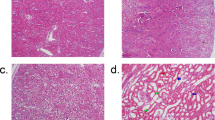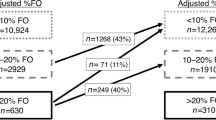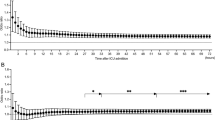Abstract
Extensive rhabdomyolysis is often lethal unless treated immediately. Early mortality arises from hypovolemic shock, hyperkalemia, acidosis and myoglobinuric acute kidney injury (AKI). Many individuals with rhabdomyolysis could be saved, and myoglobinuric AKI prevented, by early vigorous fluid resuscitation with ≥12 l daily intravenous infusion of alkaline solution started at the scene of injury. This regimen stabilizes the circulation and mobilizes edema fluids sequestered in the injured muscles into the circulation, corrects hyperkalemia and acidosis, and protects against the nephrotoxic effects of myoglobinemia and hyperuricosuria. This regime results in a large positive fluid balance, which is well tolerated in young, carefully monitored individuals. In patients with rhabdomyolysis caused by muscle crush syndrome, mortality has been reduced from nearly 100% to <20% over the past 70 years through utilization of this intervention. This Perspectives discusses the lifesaving and limb-saving potential of early vigorous fluid resuscitation in patients with extensive traumatic and nontraumatic rhabdomyolysis.
This is a preview of subscription content, access via your institution
Access options
Subscribe to this journal
Receive 12 print issues and online access
$209.00 per year
only $17.42 per issue
Buy this article
- Purchase on Springer Link
- Instant access to full article PDF
Prices may be subject to local taxes which are calculated during checkout

Similar content being viewed by others
References
Vanholder, R., Sever, M. S., Erek, E. & Lameire, N. Rhabdomyolysis. J. Am. Soc. Nephrol. 11, 1553–1561 (2000).
Bosch, X., Poch, E. & Grau, J. M. Rhabdomyolysis and acute kidney injury. N. Engl. J. Med. 361, 62–72 (2009).
Malinoski, D. J., Slater, M. S. & Mullins, R. J. Crush injury and rhabdomyolysis. Crit. Care Clin. 20, 171–192 (2004).
Slater, M. S. & Mullins, R. J. Rhabdomyolysis and myoglobinuric renal failure in trauma and surgical patients: a review. J. Am. Coll. Surg. 186, 693–716 (1998).
Schrier, R. W. Early intervention in acute kidney injury. Nat. Rev. Nephrol. 6, 56–59 (2010).
Schrier, R. W. Fluid administration in critically ill patients with acute kidney injury. Clin. J. Am. Soc. Nephrol. 5, 733–739 (2010).
Bouchard, J. & Mehta, R. L. Fluid accumulation and acute kidney injury: consequence or cause. Curr. Opin. Crit. Care 15, 509–513 (2009).
Benedetto, U. et al. Acute kidney injury after coronary artery bypass grafting: does rhabdomyolysis play a role? J. Thorac. Cardiovasc. Surg. 140, 464–470 (2010).
Solez, K. et al. International dialysis aid in earthquakes and other disasters. Kidney Int. 44, 479–483 (1993).
Hatamizadeh, P. et al. Epidemiologic aspects of the Bam earthquake in Iran: the nephrologic perspective. Am. J. Kidney Dis. 47, 428–438 (2006).
Vanholder, R., Stuard, S., Bonomini, M. & Sever, M. S. Renal disaster relief in Europe: the experience at L'Aquila, Italy, in April 2009. Nephrol. Dial. Transplant. 24, 3251–3255 (2009).
Vanholder, R. et al. Earthquakes and crush syndrome casualties: lessons learned from the Kashmir disaster. Kidney Int. 7, 17–23 (2007).
Barbera, J. A. & Cadoux, C. G. Search, rescue, and evacuation. Crit. Care Clin. 7, 321–337 (1991).
Ashkenazi, I. et al. Prehospital management of earthquake casualties buried under rubble. Prehosp. Disaster Med. 20, 122–133 (2005).
Agu, O. & Ackroyd, J. S. Crush syndrome after isolated abdominal crush injury in flood water. J. Trauma 53, 378–379 (2002).
Heppenstall, R. B., Scott, R., Sapega, A., Park, Y. S. & Chance, B. A comparative study of the tolerance of skeletal muscle to ischemia. Tourniquet application compared with acute compartment syndrome. J. Bone Joint Surg. Am. 68, 820–828 (1986).
Mubarak, J. S. Compartment syndromes and Volkmann's contracture. 207–226 (W. B. Saunders, Philadelphia, 1981).
Better, O. S. History of the crush syndrome: from the earthquakes of Messina, Sicily 1909 to Spitak, Armenia 1988. Am. J. Nephrol. 17, 392–394 (1997).
Freedman, B. J. Dr. Edward Wilson of the Antarctic. Proc. R. Soc. Med. 47, 183–189 (1954).
Better, O. S., Rubinstein, I. & Reis, D. N. Muscle crush compartment syndrome: fulminant local edema with threatening systemic effects. Kidney Int. 63, 1155–1157 (2003).
Reis, N. D. & Better, O. S. Mechanical muscle-crush injury and acute muscle-crush compartment syndrome: with special reference to earthquake casualties. J. Bone Joint Surg. Br. 87, 450–453 (2005).
Bywaters, E. G. & Beal, D. Crush injuries with impairment of renal function. BMJ 1, 427–432 (1941).
Bywaters, E. G. 50 years on: the crush syndrome. BMJ 301, 1412–1415 (1990).
Better, O. S., Rubinstein, I., Winaver, J. M. & Knochel, J. P. Mannitol therapy revisited (1940–1997). Kidney Int. 52, 886–894 (1997).
Bywaters, E. G. L. & Knochel, J. P. Comments in Milestones Nephrology, Crush injuries with impairment of renal function (reprinted). J. Am. Soc. Nephrol. 9, 322–332 (1998).
Sever, M. S., Vanholder, R. & Lameire, N. Management of crush-related injuries after disasters. N. Engl. J. Med. 354, 1052–1063 (2006).
Sever, M. S. The crush syndrome. 146–163 (Karger, Basel, 2005).
Hwang, S. J., Shu, K. H., Lain, J. D. & Yang, W. C. Renal replacement therapy at the time of the Taiwan Chi-Chi earthquake. Nephrol. Dial. Transplant. 16 (Suppl. 5), 78–82 (2001).
Gunal, A. I. et al. Early and vigorous fluid resuscitation prevents acute renal failure in the crush victims of catastrophic earthquakes. J. Am. Soc. Nephrol. 15, 1862–1867 (2004).
Williams, M. E. & Epstein, F. H. in The Regulation of Potassium Balance Ch. 1 (eds Seldin, D. W. & Giebisch, G.) 3–20 (Raven, New York, 1989).
Knochel, J. P. Rhabdomyolysis and myoglobinuria. Semin. Nephrol. 1, 75–86 (1981).
Better, O. S. & Stein, J. H. Early management of shock and prophylaxis of acute renal failure in traumatic rhabdomyolysis. N. Engl. J. Med. 322, 825–829 (1990).
Better, O. S. et al. The mechanism of muscle injury in the crush syndrome: ischemic versus pressure-stretch myopathy. Miner. Electrolyte Metab. 16, 181–184 (1990).
Carafoli, E. & Penniston, J. T. The calcium signal. Sci. Am. 253, 70–78 (1985).
Rubinstein, I. et al. Involvement of nitric oxide system in experimental muscle crush injury. J. Clin. Invest. 101, 1325–1333 (1998).
Manfredi, A. A. & Rovere-Querini, P. The mitochondrion—a Trojan horse that kicks off inflammation? N. Engl. J. Med. 362, 2132–2134 (2010).
Clausen, T. & Everts, M. E. Regulation of the Na, K-pump in skeletal muscle. Kidney Int. 35, 1–13 (1989).
Zager, R. A. Rhabdomyolysis and myohemoglobinuric acute renal failure. Kidney Int. 49, 314–326 (1996).
Bywaters, E. G. & Stead, J. K. The production of renal failure following injection of solution containing myohaemoglobin. Q. J. Exp. Physiol. 33, 53–70 (1944).
Shimazu, T. et al. Fluid resuscitation and systemic complications in crush syndrome: 14 Hanshin-Awaji earthquake patients. J. Trauma 42, 641–646 (1997).
Oda, J. et al. Analysis of 372 patients with crush syndrome caused by the Hanshin-Awaji earthquake. J. Trauma 42, 470–475 (1997).
Sever, M. S. et al. The Marmara earthquake: admission laboratory features of patients with nephrological problems. Nephrol. Dial. Transplant. 17, 1025–1031 (2002).
Vanholder, R., Sever, M. S., De Smet, M., Erek, E. & Lameire, N. Intervention of the Renal Disaster Relief Task Force in the 1999 Marmara, Turkey earthquake. Kidney Int. 59, 783–791 (2001).
Eneas, J. F., Schoenfeld, P. Y. & Humphreys, M. H. The effect of infusion of mannitol-sodium bicarbonate on the clinical course of myoglobinuria. Arch. Intern. Med. 139, 801–805 (1979).
Ron, D. et al. Prevention of acute renal failure in traumatic rhabdomyolysis. Arch. Intern. Med. 144, 277–280 (1984).
Altintepe, L. et al. Early and intensive fluid replacement prevents acute renal failure in the crush cases associated with spontaneous collapse of an apartment in Konya. Ren. Fail. 29, 737–741 (2007).
Myers, B. D. in Acute Renal Failure in the Intensive Therapy Unit. Ch. 15 (eds Bihari, D. & Nield, G.) 167–180 (Springer, London, 1990).
Barry, K. G. et al. Mannitol infusion. II. The prevention of acute functional renal failure during resection of an aneurysm of the abdominal aorta. N. Engl. J. Med. 264, 967–971 (1961).
van Valenberg, P. L. et al. Mannitol as an indispensable constituent of an intraoperative hydration protocol for the prevention of acute renal failure after renal cadaveric transplantation. Transplantation 44, 784–788 (1987).
DeFronzo, R. A. & Bia, M. in The Kidney: Physiology and Pathophysiology Ch. 14 (eds Seldin, D. W. & Giebisch, G.) 1179–1206 (Raven, New York, 1985).
Knochel, J. P. in The Regulation of Potassium Balance Ch. 2 (eds Seldin, D. W. & Giebisch, G.) 31–55 (Raven, New York, 1989).
McKechnie, J. K., Leary, W. P. & Joubert, S. M. Some electrocardiographic and biochemical changes recorded in marathon runners. S. Afr. Med. J. 41, 722–725 (1967).
Schaller, M. D., Fischer, A. P. & Perret, C. H. Hyperkalemia. A prognostic factor during acute severe hypothermia. JAMA 264, 1842–1845 (1990).
Allister, C. Cardiac arrest after crush injury. Br. Med. J. (Clin. Res. Ed.) 287, 531–532 (1983).
Hudson, J. B., Chobanian, A. V. & Relman, A. S. Hypoaldosteronism—a clinical study of a patient with an isolated adrenal mineralocorticoid deficiency, resulting in hyperkalemia and Stokes–Adams attacks. N. Engl. J. Med. 257, 529–536 (1957).
Montague, B. T., Ouellette, J. R. & Buller, G. K. Retrospective review of the frequency of ECG changes in hyperkalemia. Clin. J. Am. Soc. Nephrol. 3, 324–330 (2008).
Burns, K., Cone, D. C. & Portereiko, J. V. Complex extrication and crush injury. Prehosp. Emerg. Care 14, 240–244 (2010).
Allon, M. Hyperkalemia in end-stage renal disease: mechanisms and management. J. Am. Soc. Nephrol. 6, 1134–1142 (1995).
Sterns, R. H., Rojas, M., Bernstein, P. & Chennupati, S. Ion-exchange resins for the treatment of hyperkalemia: are they safe and effective? J. Am. Soc. Nephrol. 21, 733–735 (2010).
Boutaud, O. et al. Acetaminophen inhibits hemoprotein-catalyzed lipid peroxidation and attenuates rhabdomyolysis-induced renal failure. Proc. Natl Acad. Sci. USA 107, 2699–2704 (2010).
Nickolas, T. L., Barasch, J. & Devarajan, P. Biomarkers in acute and chronic kidney disease. Curr. Opin. Nephrol. Hypertens. 17, 127–132 (2008).
Vaidya, V. S., Ferguson, M. A. & Bonventre, J. V. Biomarkers of acute kidney injury. Annu. Rev. Pharmacol. Toxicol. 48, 463–493 (2008).
Devarajan, P. Neutrophil gelatinase-associated lipocalin (NGAL): a new marker of kidney disease. Scand. J. Clin. Lab. Invest. 241 (Suppl.), 89–94 (2008).
Haase, M. et al. Accuracy of neutrophil gelatinase-associated lipocalin (NGAL) in diagnosis and prognosis in acute kidney injury: a systematic review and meta-analysis. Am. J. Kidney Dis. 54, 1012–1024 (2009).
Mitchell, J. H., Wildenthal, K. & Johnson, R. L. Jr The effects of acid-base disturbances on cardiovascular and pulmonary function. Kidney Int. 1, 375–389 (1972).
Author information
Authors and Affiliations
Contributions
Both authors contributed equally to all aspects of this article.
Corresponding author
Ethics declarations
Competing interests
The authors declare no competing financial interests.
Rights and permissions
About this article
Cite this article
Better, O., Abassi, Z. Early fluid resuscitation in patients with rhabdomyolysis. Nat Rev Nephrol 7, 416–422 (2011). https://doi.org/10.1038/nrneph.2011.56
Published:
Issue Date:
DOI: https://doi.org/10.1038/nrneph.2011.56
This article is cited by
-
Prevalence of Rhabdomyolysis Following Bariatric Surgery and its Associated Risk Factors: a Meta-Analysis
Obesity Surgery (2023)
-
Bomb blast: imaging findings, treatment and clinical course of extremity traumas
BMC Emergency Medicine (2021)
-
Myopathies Related to Glycogen Metabolism Disorders
Neurotherapeutics (2018)
-
Comparison of two fluid solutions for resuscitation in a rabbit model of crush syndrome
Clinical and Experimental Nephrology (2015)
-
Disaster nephrology: crush injury and beyond
Kidney International (2014)



